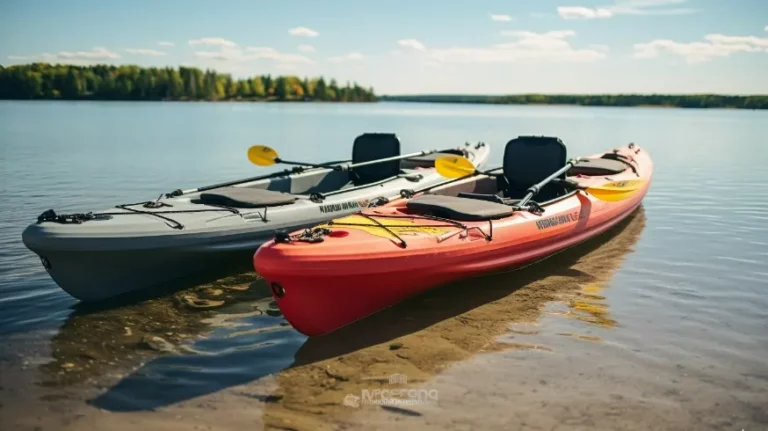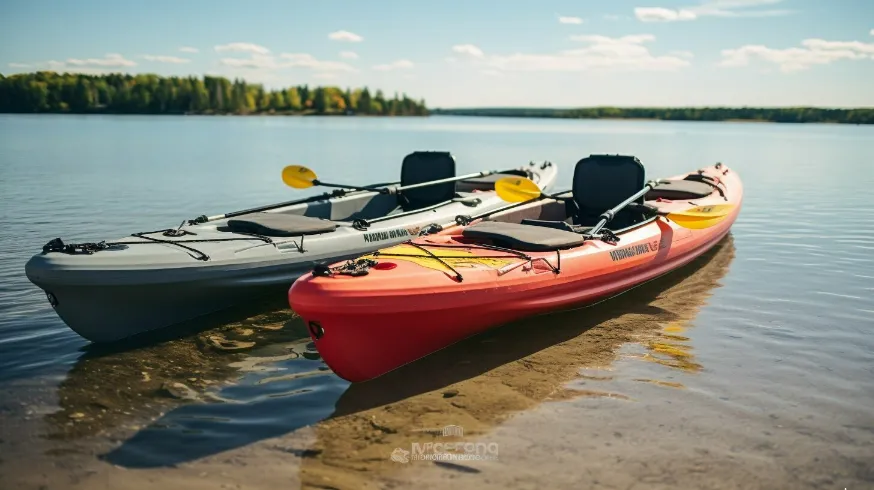When choosing a kayak, it’s essential to understand the differences between rotomolded and thermoformed kayaks, as they are two popular options with distinct features and benefits. Rotomolded kayaks are made using the rotational molding process, resulting in a durable and impact-resistant kayak. Thermoformed kayaks, on the other hand, are created over a mold using ABS plastic sheet material with a thin top layer of acrylic. Both types of kayaks are strong and resistant to impact, but there are notable differences in weight, versatility, and maintenance requirements.
Key Takeaways:
- Rotomolded kayaks are made using the rotational molding process, resulting in a durable and impact-resistant kayak.
- Thermoformed kayaks are created over a mold using ABS plastic sheet material with a thin top layer of acrylic, offering a glossy finish and versatility.
- Rotomolded kayaks are heavier compared to thermoformed kayaks, which makes them more stable but less maneuverable.
- Rotomolded kayaks are versatile and can withstand various environments, making them suitable for different types of kayaking.
- Thermoformed kayaks require some level of maintenance, although they may be more prone to cracking or breaking if they experience high-pressure impact.
Understanding Rotomolded Kayaks
Rotomolded kayaks are constructed using a process called rotational molding, which involves heating and rotating polyethylene to create a single-piece kayak that offers durability and versatility. This kayak manufacturing technique ensures that the kayak has a consistent thickness throughout, making it highly resistant to impacts and capable of withstanding rough conditions.
One of the key advantages of rotomolded kayaks is their ability to handle different environments. Whether you’re paddling on calm lakes or navigating whitewater rapids, a rotomolded kayak can provide the stability and strength needed for a secure and enjoyable experience. These kayaks are designed to be tough, allowing you to confidently explore various water environments without worrying about damaging the hull or deck.
Additionally, rotomolded kayaks are available in different types and designs to suit different preferences and needs. From recreational kayaks for casual paddlers to touring kayaks for longer expeditions, there is a wide range of options to choose from. Some rotomolded kayaks even come with folding capabilities, making them convenient for storage and transportation.
| Advantages of Rotomolded Kayaks: |
|---|
| 1. Durable and impact-resistant construction |
| 2. Versatile for various water environments |
| 3. Wide range of designs and options |
| 4. Suitable for recreational and touring purposes |
| 5. Some models offer folding capabilities for easy storage and transportation |
In summary, rotomolded kayaks are a popular choice for enthusiasts and beginners alike due to their durability, versatility, and wide range of options. Whether you’re cruising on calm waters or tackling challenging rapids, a rotomolded kayak can provide the strength and stability needed to enhance your kayaking experience.
Exploring Thermoformed Kayaks
Thermoformed kayaks are created using a thermoforming process that involves shaping ABS plastic sheet material with a top layer of acrylic, resulting in a durable and lightweight kayak with excellent rigidity. This construction method produces kayaks that are known for their glossy finish and versatility.
Thermoformed kayaks offer a number of advantages. The outer layer of acrylic provides scratch resistance, ensuring that your kayak stays looking newer for longer. The acrylic layer also offers UV protection, preventing the kayak from fading or degrading when exposed to sunlight. Additionally, thermoformed kayaks are highly rigid, providing enhanced stability and performance on the water.
When comparing thermoformed kayaks to other materials such as composite or fiberglass, one of the key benefits is their durability. Thermoformed kayaks are resistant to impact and are less likely to scratch or dent compared to their counterparts. However, it’s worth noting that high-pressure impacts may cause the kayak to crack or break.
In terms of maintenance, thermoformed kayaks require regular care and cleaning, just like other kayak materials. They can be easily cleaned with mild soap and water, and it’s important to avoid using abrasive cleaners that could damage the acrylic layer. Thermoformed kayaks can also be repaired in case of minor damage, although extensive repairs may require professional assistance.
| Advantages of Thermoformed Kayaks |
|---|
| Lightweight |
| Durable and impact-resistant |
| Glossy finish |
| Scratch resistance |
| UV protection |
| Excellent rigidity |
| Easy to clean and maintain |
In summary, thermoformed kayaks offer a compelling option for paddlers seeking a durable, lightweight, and versatile kayak. The thermoforming process results in a kayak with a glossy finish, excellent rigidity, and enhanced performance on the water. While they require regular care and maintenance, thermoformed kayaks are resistant to impact and provide a high level of durability for various kayaking adventures.
Performance and Durability Comparison
When it comes to performance and durability, rotomolded and thermoformed kayaks have distinct qualities due to their construction and the materials used. Rotomolded kayaks, also known as rotomolded polyethylene kayaks, are made through the rotational molding process. The polyethylene material used in their construction makes them incredibly durable and impact-resistant. They are popular for their ability to withstand rough use and withstands high-pressure impacts. The hull and deck of rotomolded kayaks are usually bonded together with resin or welded together using heat, resulting in a single-piece kayak that is strong and sturdy.
On the other hand, thermoformed kayaks are created over a mold using ABS plastic sheet material with a thin top layer of acrylic. This process gives them a glossy finish and a sleek look. Thermoformed kayaks offer good rigidity and strength, while also being lightweight. The ABS plastic layer provides protection against scratches and UV damage, making them ideal for kayakers who frequently paddle in sunny or saltwater environments. However, it’s important to note that thermoformed kayaks are generally not as impact-resistant as rotomolded kayaks and may be prone to cracking or breaking if subjected to high-pressure impacts.
While both types of kayaks are designed to be durable and capable of withstanding various conditions, there are some differences to consider. Rotomolded kayaks, being made of a heavier material, tend to be more stable in the water and can handle rough waters better. They are often the preferred choice for whitewater kayaking and for paddlers who prioritize stability. Thermoformed kayaks, on the other hand, are known for their lightweight nature, making them easier to maneuver and transport. They are a popular choice for long-distance touring and recreational kayaking.
In terms of maintenance and care, both rotomolded and thermoformed kayaks require some level of attention. Rotomolded kayaks are generally easier to repair, with small damages often fixable by melting and smoothing the polyethylene material. Thermoformed kayaks require more specialized repairs and may involve patching or replacing the ABS plastic sheet. Regular cleaning, proper storage, and checking for any signs of damage are necessary for both types of kayaks to ensure their longevity and performance.
| Rotomolded Kayaks | Thermoformed Kayaks |
|---|---|
| Durable and impact-resistant | Glossy finish and sleek look |
| Stable in rough waters | Lightweight and easy to maneuver |
| Easier to repair | Specialized repairs may be required |
When choosing between rotomolded and thermoformed kayaks, it’s important to consider your specific needs, preferences, and the environment in which you plan to paddle. Rotomolded kayaks are a reliable choice for those seeking durability and stability, while thermoformed kayaks offer a lightweight and stylish option for those looking for ease of use and a sleek appearance. Ultimately, your personal preferences and intended usage will guide your decision in selecting the right kayak for your needs.
Considerations for Different Environments
The choice between rotomolded and thermoformed kayaks depends on the specific environment in which they will be used, as each material offers distinct benefits and considerations. Rotomolded kayaks are known for their durability and impact resistance, making them suitable for a wide range of environments. They are able to withstand rough waters, including whitewater and sea kayaking. These kayaks are built using a single-piece construction, making them strong and able to handle the challenges of different water conditions. Rotomolded kayaks are also popular among anglers and recreational paddlers because of their stability and versatility.
On the other hand, thermoformed kayaks are appreciated for their lightweight nature and glossy finishes. These kayaks offer exceptional maneuverability and are often favored by paddlers who seek speed and responsiveness. Thermoformed kayaks are ideal for calm waters such as lakes and slow-moving rivers. They provide a smooth and efficient paddling experience, making them suitable for recreational use and touring. However, it’s important to note that thermoformed kayaks may be more prone to cracking or breaking if they experience high-pressure impact, so they may not be the best choice for rough conditions or extreme water sports.
In summary, when choosing between rotomolded and thermoformed kayaks, it’s crucial to consider the specific environment in which the kayak will be used. Rotomolded kayaks are built for durability and can handle rough waters, making them a versatile choice for various conditions. Thermoformed kayaks, on the other hand, offer lightweight maneuverability and are best suited for calm waters. By considering your paddling needs and the type of water conditions you will encounter, you can make an informed decision and select the kayak material that best suits your preferences.
| Rotomolded Kayaks | Thermoformed Kayaks |
|---|---|
| Strong and durable | Lightweight |
| Impact resistant | Responsive and maneuverable |
| Versatile for various water conditions | Ideal for calm waters |
| Stable and suitable for fishing | Smooth and efficient paddling experience |
| Single-piece construction | May be prone to cracking or breaking under high-pressure impact |
Maintenance and Care
Proper maintenance and care are essential for ensuring the longevity of rotomolded and thermoformed kayaks, as each material may have specific requirements. By following these guidelines, you can keep your kayak in excellent condition for years to come.
Rotomolded Kayaks
Rotomolded kayaks are known for their durability and impact resistance. To maintain the integrity of the kayak, it is important to inspect it regularly for any signs of wear or damage. Check for any cracks, scratches, or dents, especially after each use.
Cleaning a rotomolded kayak is relatively straightforward. Rinse it with fresh water after each use to remove any saltwater, sand, or debris. Use a soft cloth or sponge to gently scrub away any stubborn dirt or stains. Avoid using harsh chemicals or abrasive cleaners, as they may damage the kayak’s surface.
When storing your rotomolded kayak, make sure to keep it in a cool, dry place away from direct sunlight. UV rays can degrade the kayak’s plastic over time. If possible, store it indoors or use a kayak cover to provide additional protection.
Thermoformed Kayaks
Thermoformed kayaks are known for their glossy finish and versatility. While they are lightweight and offer great performance, they may require extra care to prevent cracking or breaking.
After each use, rinse the thermoformed kayak with fresh water to remove any salt or dirt. Use a mild soap solution and a soft cloth to clean any visible stains or debris. Avoid using abrasive scrub brushes or strong chemicals that could damage the acrylic layer.
When storing a thermoformed kayak, be mindful of its fragility. Avoid placing heavy objects on top of it that could cause stress or pressure points. It is recommended to store it in a cool, dry place, away from extreme temperature fluctuations.
| Maintenance and Care Tips | |
|---|---|
| Rotomolded Kayaks | Thermoformed Kayaks |
|
|
By following these maintenance and care tips, you can ensure that your rotomolded or thermoformed kayak remains in great condition and provides you with many enjoyable paddling experiences.
Conclusion
Choosing between a rotomolded kayak and a thermoformed kayak ultimately comes down to personal preferences and specific requirements, considering factors such as budget, durability, and performance.
Rotomolded kayaks, made using the rotational molding process, offer exceptional durability and impact resistance. These kayaks are constructed using rotomolded polyethylene, resulting in a sturdy and reliable watercraft. They are a popular choice for outdoor enthusiasts who need a kayak that can withstand various environments, including whitewater and sea kayaking.
On the other hand, thermoformed kayaks are crafted over a mold using ABS plastic sheet material with a thin top layer of acrylic. These kayaks are known for their glossy finish and versatility. While they may not be as impact-resistant as rotomolded kayaks, thermoformed kayaks offer a lightweight and rigid option for paddlers seeking a sleek and maneuverable kayak.
When it comes to storage, care, and repairs, both types of kayaks require some level of maintenance. Rotomolded kayaks are generally more forgiving in terms of impact, while thermoformed kayaks may be more prone to cracking or breaking if subjected to high-pressure impact. It is important to keep in mind that proper care and regular inspections are necessary to ensure the longevity of both types of kayaks.
In conclusion, the choice between a rotomolded kayak and a thermoformed kayak will depend on individual needs and preferences. Consider factors such as intended use, budget, and desired performance characteristics. By understanding the pros and cons of each material, you can make an informed decision and find the perfect kayak to suit your needs.
FAQ
Are rotomolded kayaks more durable than thermoformed kayaks?
Both rotomolded and thermoformed kayaks are strong and resistant to impact. However, rotomolded kayaks are known for their durability and ability to withstand various environments, whereas thermoformed kayaks may be more prone to cracking or breaking if they experience high-pressure impact.
Which type of kayak is lighter, rotomolded or thermoformed?
Thermoformed kayaks are generally lighter compared to rotomolded kayaks.
What are the advantages of rotomolded kayaks?
Rotomolded kayaks are versatile and can withstand various environments. They are also known for their durability and impact resistance.
What are the advantages of thermoformed kayaks?
Thermoformed kayaks have a glossy finish and are lightweight. They are also known for their rigidity and scratch resistance.
Do both types of kayaks require maintenance?
Yes, both rotomolded and thermoformed kayaks require some level of maintenance, including cleaning, storage, and repairs.
Which type of kayak material is more likely to crack or break?
Thermoformed kayaks may be more prone to cracking or breaking if they experience high-pressure impact.
How do I choose between a rotomolded and a thermoformed kayak?
The choice between the two materials depends on personal preference, needs, and budget. Consider the intended environment of use, desired durability, weight, and other factors to make an informed decision.





